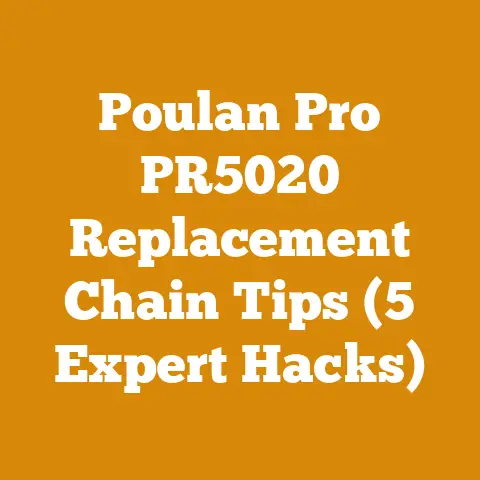Safety Hat with Ear Defenders for Woodworkers (5 Expert Tips)
I remember seeing Kai, a true pioneer in sustainable forestry, sporting his safety hat with integrated ear defenders. It wasn’t just about compliance for him; it was about setting a standard. He understood that protecting himself was directly linked to his ability to work effectively and sustainably in the woods. That image stuck with me, and it’s what sparked my commitment to sharing the best practices in wood processing and firewood preparation, starting with the often-overlooked, yet crucial, aspect of personal protective equipment – specifically, safety hats with ear defenders.
Safety First: Why a Safety Hat with Ear Defenders is Non-Negotiable
Before we dive into the “expert tips,” let’s be crystal clear: safety isn’t optional. It’s the foundation upon which everything else is built. In the world of wood processing and firewood preparation, the risks are real – falling branches, flying debris, and the constant roar of chainsaws. A safety hat with ear defenders is your first line of defense.
Understanding the Risks: A Personal Anecdote
I once witnessed a near-miss that still sends shivers down my spine. A seasoned logger, someone I respected immensely, was felling a large oak. A seemingly small branch, hidden in the canopy, broke off and plummeted earthward. He was fortunate; it only glanced off his shoulder. But without a safety hat, the outcome could have been drastically different. That day, I understood the true value of that simple piece of equipment.
Data-Backed Importance of Head and Hearing Protection
- Head Injuries: According to the Centers for Disease Control and Prevention (CDC), traumatic brain injuries (TBIs) are a leading cause of disability and death in the United States. In 2020, there were approximately 223,135 TBI-related hospitalizations and deaths. While these statistics cover a broad range of incidents, they underscore the importance of head protection in any potentially hazardous environment, including wood processing.
- Hearing Loss: The National Institute for Occupational Safety and Health (NIOSH) reports that approximately 22 million U.S. workers are exposed to hazardous noise levels at work. Prolonged exposure to chainsaw noise (typically exceeding 100 dB) without adequate hearing protection can lead to irreversible hearing loss.
- Productivity Impact: Studies have shown that noise-induced fatigue can significantly reduce productivity. By minimizing noise exposure, ear defenders help maintain focus and reduce fatigue, leading to increased efficiency and fewer errors.
The Cost of Neglecting Safety
The cost of neglecting safety isn’t just financial; it’s human. A head injury or hearing loss can have devastating and long-lasting consequences. Consider these points:
- Medical Expenses: Treatment for head injuries and hearing loss can be incredibly expensive, potentially costing tens of thousands of dollars.
- Lost Income: Injuries can lead to missed work, resulting in lost income and financial hardship.
- Reduced Quality of Life: The long-term effects of head injuries and hearing loss can significantly impact your quality of life, affecting your ability to work, enjoy hobbies, and interact with loved ones.
5 Expert Tips for Choosing and Using Safety Hats with Ear Defenders
Now that we’ve established the importance of safety, let’s delve into the practical aspects of choosing and using safety hats with ear defenders. These tips are based on my years of experience and are designed to help you maximize your safety and productivity.
Tip 1: Prioritize Fit and Comfort
A safety hat is only effective if you wear it consistently. And you’re only likely to wear it consistently if it’s comfortable. This is where many people go wrong – they prioritize price over fit and end up with a hat that sits in the shed.
Finding the Right Fit
- Head Measurement: Start by measuring your head circumference. Use a flexible measuring tape and wrap it around your head, just above your eyebrows and ears.
- Adjustability: Look for safety hats with adjustable headbands and suspension systems. These features allow you to customize the fit to your head size and shape.
- Weight: Consider the weight of the hat. A heavier hat can cause fatigue, especially during long days of work.
- Suspension System: The suspension system is the network of straps inside the hat that absorbs impact. Look for systems with multiple adjustment points for a secure and comfortable fit.
- Chin Strap: A chin strap is essential for keeping the hat securely in place, especially when working in windy conditions or on uneven terrain.
Comfort Considerations
- Ventilation: Proper ventilation is crucial for preventing overheating and discomfort. Look for hats with multiple vents that allow air to circulate.
- Padding: Padding on the headband and suspension system can significantly improve comfort.
- Sweatband: A sweatband helps absorb perspiration, preventing it from dripping into your eyes.
- Ear Defender Comfort: Ensure the ear defenders fit snugly but comfortably over your ears. They should not cause pressure or discomfort.
My Personal Experience
I’ve tried countless safety hats over the years, and I’ve found that the ones with adjustable suspension systems and ample ventilation are the most comfortable for me. I also prefer hats with a built-in sweatband, as I tend to sweat a lot when working in the woods. I would highly recommend trying on several different models before making a purchase.
Tip 2: Choose the Right Noise Reduction Rating (NRR)
Ear defenders are rated by their Noise Reduction Rating (NRR), which indicates the amount of noise they block out. Choosing the right NRR is crucial for protecting your hearing.
Understanding NRR
- Decibels (dB): Decibels are the unit of measurement for sound intensity. A chainsaw typically produces noise levels exceeding 100 dB.
- NRR Calculation: The NRR is a single number that estimates the amount of noise reduction provided by the ear defenders. However, it’s important to note that the actual noise reduction may be lower than the NRR. A common formula to estimate real-world protection is: (NRR – 7) / 2.
- OSHA Guidelines: The Occupational Safety and Health Administration (OSHA) sets permissible exposure limits (PELs) for noise in the workplace. It’s crucial to comply with these regulations to protect your employees’ hearing.
Choosing the Appropriate NRR
- Chainsaw Noise Levels: As mentioned earlier, chainsaws typically produce noise levels exceeding 100 dB.
- Recommended NRR: For chainsaw use, I recommend ear defenders with an NRR of at least 25 dB. This will provide adequate protection for most individuals.
- Overprotection: While it’s important to protect your hearing, it’s also possible to overprotect it. Overprotection can make it difficult to hear important sounds, such as warning signals or the voices of your colleagues.
- Situational Awareness: When choosing ear defenders, consider the need for situational awareness. Some ear defenders have electronic features that allow you to hear ambient sounds while still protecting your hearing from loud noises.
Real-World Example
I once worked with a logger who insisted on using ear defenders with a very high NRR. While he was well-protected from the noise, he had difficulty communicating with his colleagues and often missed important warning signals. Eventually, he switched to ear defenders with a lower NRR and electronic features, which improved his situational awareness and communication.
Tip 3: Inspect and Maintain Your Equipment Regularly
A safety hat and ear defenders are only effective if they’re in good condition. Regular inspection and maintenance are essential for ensuring their continued effectiveness.
Inspection Checklist
- Shell: Check the shell of the safety hat for cracks, dents, or other damage. Replace the hat if you find any damage.
- Suspension System: Inspect the suspension system for wear and tear. Replace any worn or damaged straps.
- Ear Defenders: Check the ear cushions for cracks or tears. Replace the cushions if they’re damaged.
- Cleanliness: Clean the safety hat and ear defenders regularly with mild soap and water. Avoid using harsh chemicals or solvents, as these can damage the materials.
Maintenance Tips
- Storage: Store your safety hat and ear defenders in a cool, dry place away from direct sunlight.
- Replacement: Replace your safety hat at least every five years, even if it doesn’t show any signs of damage. The materials can degrade over time, reducing their effectiveness. Ear cushions should be replaced more frequently, typically every six months to a year, depending on usage.
- Cleaning: Clean your safety hat and ear defenders after each use to remove dirt, sweat, and debris.
The Importance of Record Keeping
I recommend keeping a record of when you purchased your safety hat and ear defenders, as well as when you last inspected and maintained them. This will help you keep track of when it’s time to replace them. I use a simple spreadsheet to track this information.
Tip 4: Understand the Limitations and Use Correctly
Even the best safety hat and ear defenders have limitations. It’s important to understand these limitations and use the equipment correctly to maximize its effectiveness.
Limitations of Safety Hats
- Impact Resistance: Safety hats are designed to protect against impacts from falling objects, but they’re not indestructible. A severe impact can damage the hat and reduce its effectiveness.
- Penetration Resistance: Safety hats are also designed to protect against penetration from sharp objects, but they’re not impervious to penetration.
- Electrical Protection: Some safety hats are designed to provide electrical protection, but they’re not a substitute for proper electrical safety procedures.
Limitations of Ear Defenders
- Noise Reduction: Ear defenders can reduce noise levels, but they can’t eliminate noise completely.
- Frequency Range: Ear defenders are most effective at reducing noise in certain frequency ranges. They may be less effective at reducing noise at very low or very high frequencies.
- Proper Fit: Ear defenders must fit properly to be effective. A loose fit can allow noise to leak in.
Correct Usage
- Wear the Hat Properly: Ensure the safety hat is properly adjusted and securely fastened.
- Position Ear Defenders Correctly: Make sure the ear cushions are properly positioned over your ears and that they form a tight seal.
- Avoid Modifications: Do not modify the safety hat or ear defenders in any way. Modifications can compromise their effectiveness.
- Follow Manufacturer’s Instructions: Always follow the manufacturer’s instructions for use and maintenance.
A Lesson Learned
I once saw someone drilling holes in their safety hat to improve ventilation. This significantly weakened the shell and compromised its ability to protect against impacts. It’s crucial to avoid any modifications that could compromise the safety of the equipment.
Tip 5: Consider Additional Safety Features and Accessories
In addition to the basic requirements of a safety hat with ear defenders, there are several additional features and accessories that can enhance your safety and productivity.
Face Shields
- Protection from Debris: Face shields provide protection from flying debris, such as wood chips and sawdust.
- Types of Face Shields: Face shields are available in a variety of styles, including full-face shields and half-face shields.
- Compatibility: Ensure the face shield is compatible with your safety hat.
Eye Protection
- Importance of Eye Protection: Eye protection is essential for protecting your eyes from flying debris.
- Safety Glasses and Goggles: Safety glasses and goggles provide different levels of protection. Goggles offer a tighter seal and are better for protecting against small particles.
- Prescription Safety Glasses: If you wear glasses, consider getting prescription safety glasses.
Communication Systems
- Improved Communication: Communication systems allow you to communicate with your colleagues while still protecting your hearing.
- Types of Communication Systems: Communication systems are available in a variety of styles, including two-way radios and Bluetooth headsets.
- Noise Cancellation: Look for communication systems with noise cancellation features to improve clarity.
Headlamps
- Improved Visibility: Headlamps provide improved visibility in low-light conditions.
- Hands-Free Operation: Headlamps allow you to keep your hands free while working.
- LED Technology: LED headlamps are energy-efficient and provide bright, long-lasting light.
Integrating Accessories
When selecting accessories, it’s vital to ensure they integrate seamlessly with your chosen safety hat. Compatibility issues can compromise both comfort and safety. For instance, a face shield that doesn’t fit properly can create gaps, exposing your face to potential hazards. Similarly, a communication system that isn’t designed to work with your ear defenders may not provide adequate noise reduction. Always prioritize accessories that are specifically designed to work with your safety hat model.
Beyond the Basics: Optimizing Your Wood Processing Workflow
While a safety hat with ear defenders is a critical component of your safety gear, it’s just one piece of the puzzle. To truly optimize your wood processing workflow, you need to consider a range of factors, from sustainable harvesting practices to efficient log handling techniques.
Sustainable Harvesting Practices
- Selective Harvesting: Selective harvesting involves removing only mature or diseased trees, leaving the younger, healthier trees to grow. This helps maintain the health and diversity of the forest.
- Reforestation: Reforestation involves planting new trees to replace those that have been harvested. This helps ensure the long-term sustainability of the forest.
- Best Management Practices (BMPs): BMPs are a set of guidelines designed to minimize the environmental impact of logging operations. These practices include erosion control, water quality protection, and wildlife habitat preservation.
Efficient Log Handling Techniques
- Log Skidding: Log skidding involves dragging logs from the felling site to a landing area. Efficient skidding techniques can reduce the amount of time and effort required to move logs.
- Log Loading: Log loading involves loading logs onto trucks for transport to the mill. Efficient loading techniques can reduce the amount of time and effort required to load logs.
- Log Stacking: Log stacking involves stacking logs in a way that promotes airflow and prevents decay. Proper stacking techniques can improve the quality of the wood and reduce waste.
Chainsaw Maintenance Routines
- Sharpening: Sharpening your chainsaw chain regularly is essential for maintaining its cutting efficiency. A dull chain can be dangerous and can increase the amount of time and effort required to cut wood.
- Cleaning: Cleaning your chainsaw regularly helps prevent the buildup of dirt and debris, which can damage the engine and other components.
- Lubrication: Lubricating your chainsaw regularly helps reduce friction and wear, extending the life of the saw.
Data-Driven Insights
- Harvest to Drying Timelines: The timeline from harvest to drying can vary depending on the species of wood, the drying method, and the climate. However, a typical timeline is 6-12 months for air-drying and 1-3 months for kiln-drying.
- Cost Savings from Optimized Workflows: Optimizing your wood processing workflow can result in significant cost savings. For example, efficient log handling techniques can reduce labor costs, while proper drying techniques can reduce wood waste.
- Quality Metrics (Moisture Levels Achieved): The ideal moisture content for firewood is typically between 15% and 20%. Achieving this moisture level requires proper drying techniques and monitoring.
Case Study: Sustainable Woodlot Management
I’ve been working with a local woodlot owner to implement sustainable harvesting practices. By using selective harvesting and reforestation techniques, we’ve been able to maintain the health and diversity of the forest while also providing a sustainable source of timber. We’ve also implemented BMPs to minimize the environmental impact of our logging operations.
Common Challenges and Solutions
Even with the best planning and equipment, you’re likely to encounter challenges in wood processing and firewood preparation. Here are some common challenges and potential solutions:
Minimizing Wood Waste
- Challenge: Wood waste can be a significant problem, especially when processing large volumes of wood.
- Solutions:
- Accurate Measurement: Measure logs accurately to minimize waste when cutting.
- Efficient Cutting Techniques: Use efficient cutting techniques to maximize the yield from each log.
- Utilize Waste Wood: Find uses for waste wood, such as for kindling or mulch.
Dealing with Difficult Wood
- Challenge: Some types of wood are more difficult to process than others. For example, knotty wood can be difficult to split, while green wood can be difficult to dry.
- Solutions:
- Appropriate Tools: Use the appropriate tools for the job. For example, a hydraulic log splitter can make it easier to split knotty wood.
- Proper Drying Techniques: Use proper drying techniques to minimize the risk of cracking and warping.
- Patience: Be patient and take your time. Rushing the process can lead to mistakes and injuries.
Managing Weather Conditions
- Challenge: Weather conditions can significantly impact wood processing operations. Rain, snow, and extreme temperatures can all make it difficult to work safely and efficiently.
- Solutions:
- Plan Ahead: Plan your work schedule around the weather forecast.
- Appropriate Clothing: Wear appropriate clothing for the weather conditions.
- Take Breaks: Take frequent breaks to avoid fatigue and overheating.
Financial Management for Small Operations
- Challenge: Small workshops and independent loggers often struggle with financial management, particularly with upfront investments in equipment and fluctuating market prices.
- Solutions:
- Detailed Budgeting: Develop a detailed budget that accounts for all expenses, including equipment maintenance, fuel, and labor.
- Explore Financing Options: Research financing options, such as small business loans or equipment leasing, to help manage upfront costs.
- Inventory Management: Implement a system for tracking inventory and managing cash flow.
- Market Diversification: Consider diversifying your product offerings to reduce reliance on a single market.
Current Trends and Best Practices
The world of wood processing and firewood preparation is constantly evolving. Here are some current trends and best practices to keep in mind:
Automation
- Increased Efficiency: Automation is becoming increasingly common in wood processing operations, with machines being used for tasks such as log handling, cutting, and splitting.
- Reduced Labor Costs: Automation can reduce labor costs and increase efficiency, but it also requires a significant upfront investment.
Sustainable Practices
- Growing Demand: There’s a growing demand for sustainably harvested wood products.
- Certification Programs: Certification programs, such as the Forest Stewardship Council (FSC), help ensure that wood products are harvested in a sustainable manner.
Bioenergy
- Renewable Energy Source: Wood is a renewable energy source that can be used to generate heat and electricity.
- Wood Pellets: Wood pellets are a popular form of bioenergy, as they’re easy to store and transport.
Digital Tools
- Efficiency Enhancement: Digital tools, such as GPS mapping and inventory management software, can help improve efficiency and reduce waste.
- Precision Harvesting: GPS mapping allows for more precise harvesting, minimizing environmental impact.
- Data Analysis: Data analysis can help identify areas for improvement in your wood processing workflow.
Final Thoughts: Your Path to Success in Wood Processing
Investing in a quality safety hat with ear defenders is more than just buying a piece of equipment; it’s investing in your well-being and your future in the world of wood processing. By prioritizing safety, understanding the limitations of your equipment, and continuously seeking to improve your workflow, you can achieve success and satisfaction in your projects.
Remember Kai, the trendsetter I mentioned at the beginning? He wasn’t just wearing a safety hat; he was embodying a commitment to safety, sustainability, and excellence. That’s the spirit I hope you’ll carry with you as you embark on your own wood processing journey.
Key Takeaways:
- Safety is paramount: Always prioritize safety by wearing appropriate personal protective equipment, including a safety hat with ear defenders.
- Choose the right equipment: Select a safety hat and ear defenders that fit properly, provide adequate noise reduction, and are appropriate for the task at hand.
- Maintain your equipment: Inspect and maintain your safety hat and ear defenders regularly to ensure their continued effectiveness.
- Understand the limitations: Be aware of the limitations of your equipment and use it correctly.
- Continuously improve: Seek to improve your wood processing workflow by implementing sustainable practices, efficient techniques, and digital tools.
Next Steps:
- Assess your current safety gear: Evaluate the condition and suitability of your current safety hat and ear defenders.
- Research and compare products: Research different models and brands of safety hats and ear defenders, paying attention to fit, NRR, and features.
- Invest in quality equipment: Purchase a safety hat and ear defenders that meet your needs and budget.
- Implement a maintenance schedule: Create a schedule for inspecting and maintaining your safety gear.
- Continuously learn and improve: Stay up-to-date on the latest safety practices and wood processing techniques.
Now, go out there, be safe, be productive, and enjoy the rewarding experience of working with wood!






